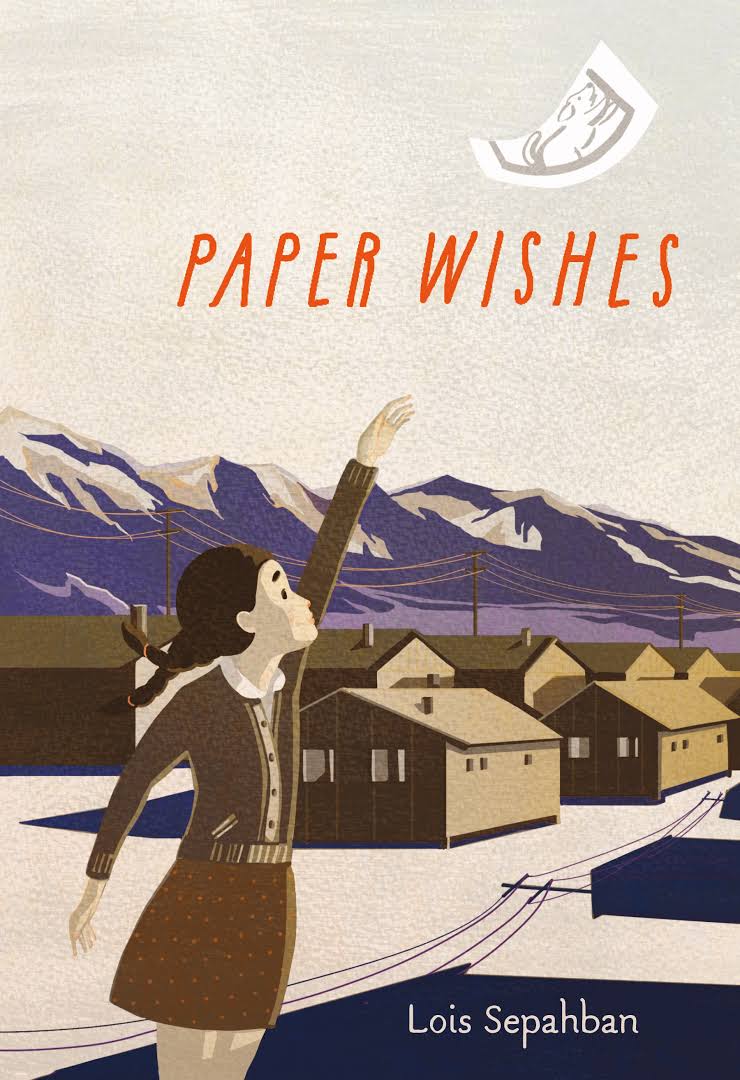Paper Wishes (book)
Creators: Lois Sepahban
Children's novel by Lois Sepahban centering on a young girl from Bainbridge Island, Washington , who turns mute when she and her family are uprooted and sent to Manzanar .
Written in the first person voice of Manami Tanaka, a girl who is around ten years old, Paper Wishes takes place from March to December 1942 (with each month serving as the title of a chapter) as the Tanakas are forcibly removed from their Bainbridge Island home and sent to Manzanar. As the story begins, Manami lives with her fisherman father, her mother, and her maternal grandfather, along with her dog, Yujiin. Her two older siblings, Keiko and Ron, are both away at college in Indiana. But rumors of forced removal soon become reality, and the Tanakas find themselves on a train to Manzanar. Worse, Manami's attempt to smuggle Yujiin along is discovered, and she is forced to leave the dog behind in Seattle. The trauma of the concentration camp and the loss of Yujiin render Manami mute, to the consternation of her family. Over the next few months, she grows close to a kindly Caucasian school teacher, whom she draws pictures for, and is heartened when her brother Ron returns from college to rejoin the family and becomes a school teacher himself. But Ron's attempts to to council what Manami refers to as the "wild boys," lands him trouble with the administration as unrest builds in the camp. Manami continues to long for Yujiin and remains mute. An ending "Author's Note" provides a brief historical summary of the wartime removal and incarceration of Japanese Americans that provides the context for the novel.
Author Lois Sepahban grew up in central California and, aware of Manzanar growing up, contemplated writing a story set there for many years. A full time teacher, she is the author of ten non-fiction books for children, mostly on science and history related topics. Paper Wishes is her first novel. [1]
Reviews for Paper Wishes have largely been positive. Naomi Hirahara in the New York Times Book Review cites Sepahban's "beautiful, spare language [that] makes Manami's voice resonate," a theme echoed by Amanda Raklovits in School Library Journal ("spare and affecting prose") and Kirkus Reviews ("simple and heart-rending prose"). [2] On the other hand, Deborah Stevenson in the Bulletin of the Center for Children's Books writes that the "language is oddly stilted and formal... distancing Manami’s narration and, ironically, making her American-born English seem strained and foreign," adding that "her elective mutism is dramatic, but it's also a well-worn literary contrivance." [3] Carolyn Phelan in Booklist calls it "is a quiet, personal story with nuanced character portrayals and resonant emotional undertones," while Jennifer M. Brabander in The Horn Book Magazine finds it "honest and engaging." But Hirahara and Brabander find the historical background on the Manzanar riot/uprising inadequate, and Hirahara also points out the "unusual" and "odd" Japanese names of key characters. [4]
Paper Wishes is well researched—Sepahban cites the use of Densho.com interviews and resources and visits to the Manzanar National Historic Site—and presents a generally accurate picture of life at Manzanar. There are a few minor historical issues, however: In June of 1942, Ron is urged to join the army by his sister and discusses the possibility with his father (page 72); but at that time, Japanese Americans were not allowed in any branch of the American armed forces and would not be until the following spring, when the army formed the 442nd Regimental Combat Team . Later, when Ron discusses the possibility of going to another camp for his own protection, he has that discussion with a soldier (150); while the army was in charge of securing the perimeters of the concentration camps, the internal administration of the camp was the purview of the War Relocation Authority (WRA), and any such discussion would have been with WRA officials. Later, when the Tanakas move to Minidoka in December 1942, the camp is described as having just opened (163); most Minidokans arrived in August and September of 1942 and by December, the camp would have been almost fully populated. Finally, in the Author's Note, it is claimed that "... about half of those imprisoned were children" (179); the real figure is about one-third .
Footnotes
- ↑ Biographical information from Sepahban's website, http://www.loissepahban.com/ , and from Natalie Aguirre's interview with her, "Lois Sepahban Interview and Paper Wishes Giveaway," Literary Rambles: Spotlighting Children's Book Authors, Agents, and Publishing , Jan. 18, 2016, http://www.literaryrambles.com/2016/01/lois-sepahban-interview-and-paper.html , both accessed on September 9, 2016.
- ↑ Naomi Hirahara, New York Times Book Review , Jan. 15, 2016, http://www.nytimes.com/2016/01/17/books/review/paper-wishes-by-lois-sepahban.html ; Amanda Raklovits, School Library Journal , Nov. 27, 2015, http://www.slj.com/2015/11/reviews/books/paper-wishes-by-lois-sepahban-slj-review/ ; Kirkus Reviews , Sept. 16, 2015, https://www.kirkusreviews.com/book-reviews/lois-sepahban/paper-wishes/ , all accessed on Sept. 9, 2016.
- ↑ Deborah Stevenson, Bulletin of the Center for Children's Books 69.6 (Feb. 2016): 325.
- ↑ Carolyn Phelan, Booklist , Oct. 15, 2015, 59; Jennifer M. Brabander, The Horn Book Magazine , May/June 2016, 113, both accessed on Sept. 9, 2016.
Find in the Digital Library of Japanese American Incarceration
This item has been made freely available in the Digital Library of Japanese American Incarceration , a collaborative project with Internet Archive .
Might also like:
Dash
by Kirby Larson;
Weedflower
by Cynthia Kadohata;
Journey to Topaz
by Yoshiko Uchida
| Author | Lois Sepahban |
|---|---|
| Pages | 185 |
| Publication Date | 2016 |
For More Information
Author website: http://www.loissepahban.com/ .
Publisher website: http://us.macmillan.com/paperwishes/loissepahban .
Reviews
Brabander, Jennifer M. The Horn Book Magazine , May/June 2016, 112–13.
Hirahara, Naomi. New York Times Book Review , Jan. 15, 2016.
Kirkus Reviews , Sept. 16, 2015.
Phelan, Carolyn. Booklist , Oct. 15, 2015, 59.
Publishers Weekly , Nov. 2, 2015, 85–86.
Raklovits, Amanda. School Library Journal , Nov. 27, 2015.
Stevenson, Deborah. Bulletin of the Center for Children's Books 69.6 (Feb. 2016): 325.
